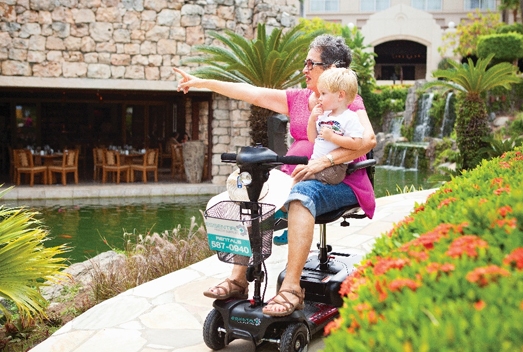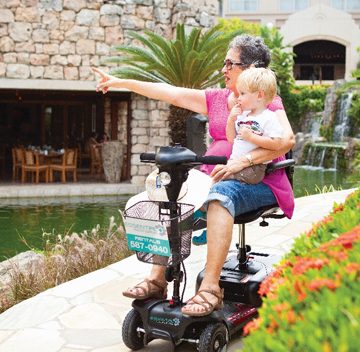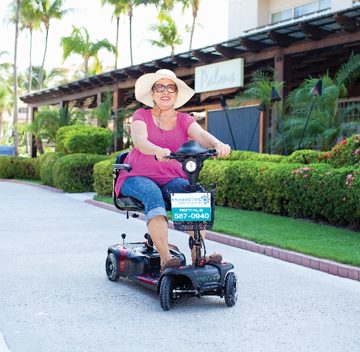Limited mobility is a common problem for the elderly and younger seniors with conditions such as arthritis and chronic tendonitis. Enjoying the simple pleasures of life becomes difficult when walking is involved. When traveling, mobility scooters can also be a great solution. It can be the perfect way to mobilize your family members who may have more difficulty keeping up and or walking, especially when accessing thru the bigger hotel properties. This will also be the case for those travelling with disabilities or who may be traveling with an injury or get injured during their travels.
Thankfully, power mobility equipment is available to those who require more accessibility in order to enjoy their vacation to the fullest. With a wide variety of different types and configurations, modern mobility scooters are an accessible and affordable solution when traveling for most people.
Choosing the Right Power Mobility Scooter
Mobility scooters are similar to power wheelchairs in that they both rely on battery-powered electric motors to help the rider enjoy ease of mobility, but that is where the similarity ends. Whereas power wheelchairs are designed for those who have great difficulty walking, mobility scooters are intended to provide a supplement to walking.
There are many models of mobility scooters and several distinct groups. Understanding the strengths and benefits of the different types of mobility scooters and how they are classified can help narrow down the choices and make renting a mobility scooter much easier.
Transportable Scooters
Portable scooters (or travel scooters) are the least expensive type of mobility scooter and are designed to be taken apart into several manageable pieces. When disassembled, the individual pieces of the travel scooter are lightweight and easy to move (the heaviest piece usually weighs less than 30 pounds). Transportable scooters can be carried in the trunk of a car without the need for a special scooter lift or rack.
While transportable scooters are a great choice for many individuals, portability comes at a cost. They usually lack some of the beneficial features of other types of mobility scooters. To reduce weight, features NOT directly related to safe operation, are excluded. Portable scooters usually support less weight, have a shorter range, and are not quite as durable as other types of mobility scooters.
Standard Mobility Scooters
Conventional mobility scooters are generally designed to be disassembled in a manner similar to that of a travel scooter, but the individual pieces are not as lightweight or easy to manage. The standard mobility scooter includes many other comfort and safety-related features, such as improved suspension, lighting systems, seating options and larger weight capacities.
Most mobility scooters feature a long base, with a chair mounted towards the rear of the base, above the batteries and electric motor. A set of handlebars, called a tiller, is used to control the direction and speed of the scooter. Because the tiller is mounted above the front wheels in front of the rider, it is not possible to drive a adult scooter directly up to a table or desk the same way you can with a wheelchair.
Typically a vehicle scooter lift is required to transport the mobility scooter. Scooters are available in three and four- wheeled versions.
Three-Wheeled Mobility Scooters
As the name implies, three-wheeled scooters are configured with two wheels in the back and a separate, articulate wheel in the front. One of the advantages of this type of scooter is its low turning radius. Three wheeled scooters are designed for maximum maneuverability and are mainly used indoors or on paved, level surfaces. Because three wheel models are not as stable as a four wheel configuration three-wheeled mobility scooters are not recommended for use on uneven terrain outdoors.
A full-size three-wheeled electric scooter can be more comfortable than a compact, transportable or four-wheeled mobility scooter. The three-wheel design offers the most legroom of the three categories, which is convenient if you are tall, have bad knees or experience leg stiffness.
Three wheeled mobility scooter are lighter in weight and have a smaller front axle, so many portable scooters use a three wheel design.
Four-Wheeled Mobility Scooters
Four-wheeled scooters provide excellent stability, with the two back wheels and two front wheels configuration making the risk of toppling over extremely slim. For individuals with any balance problems a four-wheel mobility scooter is an excellent choice.
While the double wheels in the front are not as maneuverable as their three-wheeled counterparts, four-wheeled scooters excel in providing rugged durability. The enhanced stability of the extra wheel also makes four-wheeled scooters safe at higher speeds of up to 10 mph. Some models have knobby tires and high ground clearance which make them great choices for use off-road and in rugged terrain. Many models are also able to handle steep hills and curbs.
Many four-wheel models include front and rear suspension to provide a much smoother ride than three-wheel scooters. Four wheel scooters are mainly intended for outdoor use yet most four wheel mobility scooters do maintain a turning radius that allows you to perform daily functions inside the home.
Comfort features available on some models include horn, speed setting, lights, key ignition, tilt tiller, lever controls and captain style swivel seats.
Heavy Duty Power Mobility Scooters
Heavy Duty Mobility Scooters are much larger and heavier than other types of mobility scooters, making them more difficult to transport. What they lack in portability they make up for in power, durability and versatility.
Heavy duty scooters have a much higher weight rating and are designed to perform well across all types of terrain, including off-road. They feature larger wheels, a higher ground clearance, reinforced bumpers, and many other features designed to make the device as rugged as possible.
A heavy duty scooter can be a great choice for those who like spending time outdoors because they are the most versatile and can be driven over most types of ground. Versatility comes at a cost, however, as their large size makes it necessary to use a scooter lift to transport them. Heavy duty scooters are also the most expensive type of scooter.
With the many different models, manufacturers, and options available, it is easy to become overwhelmed when you choose a mobility scooter rental, but they can be classified by the number of wheels, weight capacity, and function. Understanding these classifications and their advantages can make buying or renting a mobility scooter much easier.
For more information on mobility scooters and how to book a rental, please feel free to visit Essential Health Supplies.






